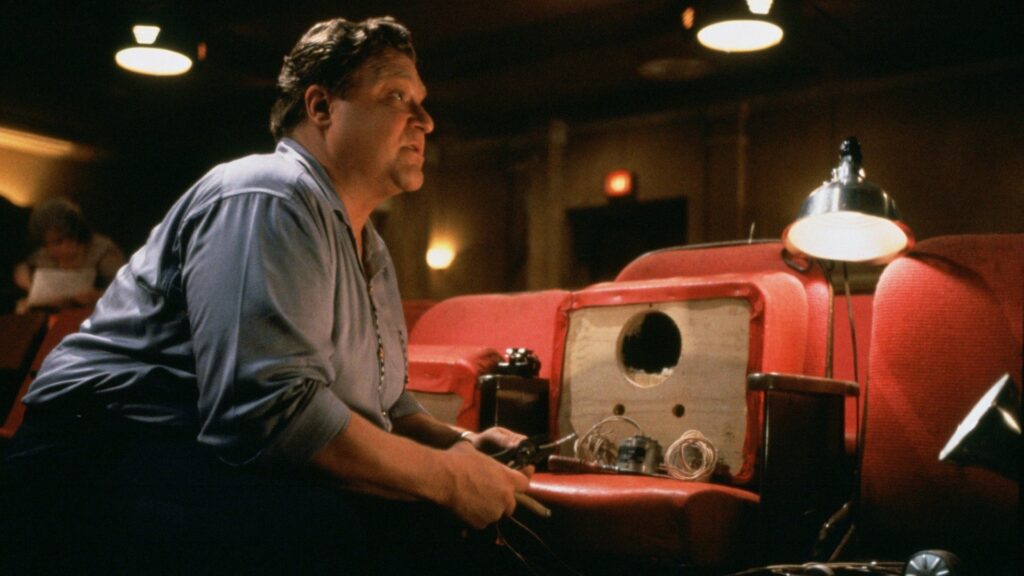
Joe Dante’s film Matinee (1993) is as much an homage to filmmaker William Castle as it is a tribute to the cinema’s role as a commentator on and reflection of our daily lives. No medium has engaged or shaped the popular imagination on the scale that the cinema did in the twentieth century. Matinee takes the historical event of the Cuban Missile Crisis and connects it to the personal moments of significance, like a first kiss, by way of the cinema. The cinema in Matinee contextualizes history while offering reflections on those personal, intimate moments that inform adolescence.
Matinee is the film that encapsulates this complex of mass media, national history, and private histories with the film-within-the-film Mant! as its conceptual glue. Mant! is the film of atomic mutants, doomed romance, Cold War paranoia, and sensationalist thrills that runs as a commentary on the events in the lives of the characters in Matinee. Mant! is exactly the kind of retro-schlock that Dante loves and Castle helped to popularize. Films like Mant!, though often expertly crafted, rise from drive-in filler to high art as the audiences whose lives they shaped mature and find in those films a facet of their own personal secret histories.
The cinema in the films of Joe Dante is forever the glue that binds society. Reflexive gags bring the Gremlins in Gremlins 2: The New Batch (1990) as close to the audience as possible while a screening of Snow White & The Seven Dwarfs (1937) helped viewers see something of their childhood in those same little monsters in Gremlins (1984). It’s the cinema that brings River Phoenix to outer space in Explorers (1985) just as the literal debris from other films provided the bulk of Hollywood Boulevard (1976) and The Movie Orgy (1968). In every instance Dante treats the cinema as the societal glue that connects people across time and space like so many cuts in a montage. None of Dante’s narrative features encapsulates this notion quite as effectively as Matinee.
And yet, for all of its conceptual weight and formal invention, Matinee is a film of small stories of an early adolescent existence in late October, 1963. Matinee effectively takes those early scenes in Gremlins of Billy going to work and preparing for Christmas and opens them up to become the entire film, relegating the fantastique of the Gremlins, aliens, or a micro-Dennis Quaid to the much anticipated movie Mant!. The threats the teenagers face in Matinee are much closer to reality than anything Joe Dante had done since Hollywood Boulevard. The terror of a half-man, half-ant paled in comparison to the terror of having one’s father deployed in the American blockade of Cuba.
The fear of nuclear holocaust is the stuff of nightmares to the residents of Key West, Florida, but it’s the stuff of inspiration to Lawrence Woolsey (John Goodman). Woolsey, the William Castle stand-in, is a showman through and through. He alone perceives Dante’s conceptual web linking national and personal histories to the spectacle of the cinema for he is both Dante’s manifestation of cinema idealization and director’s surrogate. Immediate trouble and all solutions lay in the actions and wisdom of Lawrence Woolsey who has brought a new kind of cinema to Key West and invited the townsfolk (including the young hero) to actively participate in the illusions. To that end, Woolsey is the collective imagination behind the cinema made flesh.
An alum of New World Pictures, Dante populates Matinee with his company of actors that he has slowly amassed over his career. Dick Miller, Robert Picardo, and John Sayles are the most recognizable players in this stock company, but Dante has brought Omri Katz with him too from his work on Eerie, Indiana (1991-93). Dante also re-teamed with screenwriter Charles S. Haas who had penned the script for Gremlins 2: The New Batch. This tendency of Dante’s to re-team with talent is not wholly extraordinary in the world of film, but it is another similarity that he shares with William Castle.
In a way, doing a film that’s about William Castle is a way for Dante to reflect on his own art. Woolsey is Castle in the abstract and therefore more receptive as a conduit for Dante’s own aesthetic introspection. Woolsey employs the same cast over and over, going so far as to employ their talents beyond the sets and cameras. Woolsey using actors as “nurses” (Cathy Moriarty) and “thugs” (Miller and Sayles) recalls Sayles’ work as a both an actor and writer on The Howling (1981) and Piranha (1978) while simulataneously suggesting the essential role that Dick Miller as a signifier played in establishing Joe Dante as a post-modernist auteur. Matinee is as film that records the power of cinematic spectacle and the process behind it; connecting the two as one fundamental sensory experience that the audience either chooses to acknowledge or ignore.
None of this does justice to the effects of watching Matinee. As soon as the film begins one is immediately transported to that moment in late-childhood when the emotional stakes in a movie on the screen suddenly coalesced with one’s own. Matinee, perhaps more than anything else, is a film in memory of that moment when anyone and everyone first felt themselves a part of the illusion being projected. Few filmmakers have ever authored a more moving or compelling love letter to the cinema than Joe Dante did with Matinee.
